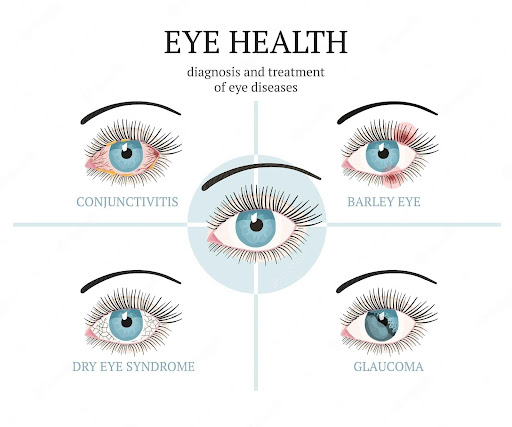The eyes, our windows to the world, are indispensable organs enabling us to experience life’s beauty. However, they are susceptible to various conditions affecting our vision and quality of life. This article will explore some of the most prevalent eye conditions, their symptoms, and the latest treatments available. By understanding these conditions and seeking appropriate care, we can maintain healthy eyesight for years.
Myopia
Myopia, commonly known as nearsightedness, is a condition that impairs distant vision. It occurs when the eyeball is too long, or the cornea is excessively curved, causing light to focus in front of the retina instead of directly on it. Symptoms of myopia include blurry vision, eye strain, headaches, and squinting. Regular eye exams are crucial for monitoring vision and ensuring up-to-date prescriptions. If left untreated, myopia can progress, leading to complications such as retinal detachment, cataracts, and glaucoma. Treatment options encompass glasses, contact lenses, or refractive surgery, which corrects how light enters the eye to achieve proper retinal focus.
Hyperopia
Hyperopia, or farsightedness, is a condition that affects near vision. It arises from an eyeball that is too short or a cornea that is too flat, causing light to focus behind the retina. As a result, individuals with hyperopia often experience blurry vision, eye strain, headaches, and difficulty focusing on nearby objects. Over time, untreated hyperopia can contribute to the development of glaucoma and amblyopia. Treatment options for hyperopia include glasses, contact lenses, or refractive surgery. Refractive surgery, such as LASIK, reshapes the cornea to correct the refractive error and restore clear vision.
Astigmatism
Astigmatism refers to an irregular curvature of the cornea or lens, resulting in the focal point of light being scattered rather than precisely focused on the retina. Symptoms include blurry vision, eye strain, headaches, and difficulty seeing at night. Regular eye exams are vital to monitor vision and maintain accurate prescriptions. If left uncorrected, astigmatism can lead to more serious conditions like keratoconus and amblyopia. Depending on the individual’s needs and preferences, treatment options encompass glasses, contact lenses, or refractive surgery.
Presbyopia
Presbyopia is an age-related condition that affects the eye’s ability to focus on nearby objects, such as reading material or computer screens. It occurs due to the gradual loss of flexibility in the eye’s lens, making it challenging to shift focus from near to far. Common symptoms include blurry vision, eye strain, headaches, and difficulty focusing on close objects. Regular eye exams are essential for monitoring vision and updating prescriptions. Treatment options for presbyopia include glasses, contact lenses, or refractive surgery. Refractive surgery, such as monovision LASIK, can address presbyopia by adjusting the focus of each eye.
Cataracts
Cataracts are a prevalent eye condition characterized by a clouding of the eye’s lens, leading to blurry or dim vision. Aging, eye trauma, and certain medical conditions can contribute to cataract formation. While they primarily affect older adults, cataracts can be treated through surgery, a safe and effective option. Symptoms of cataracts include blurry or dim vision, light sensitivity, and difficulty seeing at night. Regular eye exams are crucial for monitoring cataract progression and determining the optimal timing for surgery. During cataract surgery, the cloudy lens is removed and replaced with an artificial lens, restoring clear vision and enhancing the quality of life.
Glaucoma
Glaucoma encompasses a group of eye conditions that damage the optic nerve and can result in vision loss or blindness. It is often caused by elevated pressure within the eye, although other factors, such as poor blood flow to the optic nerve, can also contribute. In the early stages of glaucoma, individuals may not experience noticeable symptoms. However, as the condition progresses, symptoms may include peripheral vision loss, blurred vision, and difficulty seeing in low light. Therefore, regular eye exams are essential for monitoring intraocular pressure and detecting glaucoma early.
Treatment options for glaucoma include medication, laser surgery, or conventional surgery. Medications are often prescribed to reduce intraocular pressure and prevent further damage to the optic nerve. Laser surgery can improve the drainage of fluids from the eye, while conventional surgery may be necessary in more severe cases. The treatment choice depends on the severity of glaucoma and the patient’s visual needs, and an ophthalmologist best determines it.
Age-Related Macular Degeneration
Age-related macular degeneration (AMD) affects the macula, the retina’s central portion responsible for sharp, detailed vision. It is a common eye condition that primarily affects individuals over 50. AMD can result in vision loss or blindness. The disease is caused by damage to the macula, which can be attributed to aging, genetics, or lifestyle factors like smoking.
Symptoms of AMD include:
- Blurry or distorted vision.
- Difficulty seeing in low light.
- The presence of a blind spot in the center of the visual field.
Regular eye exams are crucial for monitoring the progression of AMD and determining the most suitable treatment approach. Treatment options for AMD include medication, laser surgery, or photodynamic therapy. Medicines can slow the progression of the disease, while laser surgery and photodynamic therapy target abnormal blood vessel growth in the eye.
Diabetic Retinopathy
Diabetic retinopathy is a potentially sight-threatening complication of diabetes. It occurs when the blood vessels in the retina are damaged, leading to vision loss or blindness. Diabetic retinopathy can affect individuals with both type 1 and type 2 diabetes. Effective management of blood sugar levels and regular eye exams are crucial for preventing and managing this condition.
Symptoms of diabetic retinopathy include blurry or distorted vision, floaters, and difficulty seeing in low light. Treatment options for diabetic retinopathy include medication, laser surgery, or conventional surgery. Medications can reduce swelling in the retina, while laser surgery can target abnormal blood vessel growth. The choice of treatment depends on the severity of diabetic retinopathy and the patient’s individual needs.
Treatment Options for Common Eye Conditions
The treatment options for common eye conditions vary depending on the severity of the situation and the individual’s visual needs. Refractive errors such as myopia, hyperopia, and astigmatism can often be corrected with glasses or contact lenses. Refractive surgery, such as LASIK, can provide a permanent solution by reshaping the cornea. Cataracts can be effectively treated through surgery, while conditions like glaucoma and diabetic retinopathy may require a combination of medication, laser surgery, or conventional surgery. AMD treatment often involves a combination of medication, laser surgery, or photodynamic therapy.
Lifestyle Changes to Improve Eye Health
Maintaining a healthy lifestyle can significantly improve eye health and reduce the risk of developing common eye conditions. A balanced diet rich in fruits and vegetables, maintaining a healthy weight, and avoiding smoking are essential for maintaining healthy eyes. Wearing sunglasses to protect the eyes from UV rays and limiting exposure to bright sunlight can also help prevent damage to the eyes.
Prevention Strategies for Common Eye Conditions
Preventing common eye conditions begins with regular eye exams and a healthy lifestyle. Regular eye exams allow for early detection of eye conditions and ensure that prescriptions are up-to-date. It is recommended to schedule regular comprehensive eye exams with an ophthalmologist or optometrist to monitor your eye health, even if you don’t currently have any symptoms or vision problems.
Additionally, healthy habits can greatly reduce the risk of developing common eye conditions. Here are some prevention strategies:
- Maintain a healthy diet: Eating a balanced diet rich in fruits, vegetables, and omega-3 fatty acids can help support overall eye health. Foods like leafy greens, citrus fruits, carrots, and fish high in omega-3s, such as salmon, can provide essential nutrients for your eyes.
- Manage chronic health conditions: Diabetes and high blood pressure can increase the risk of developing eye conditions like diabetic retinopathy and glaucoma. Therefore, it is important to manage these conditions by following a proper treatment plan, taking prescribed medications, and monitoring blood sugar and blood pressure levels.
- Protect your eyes from UV rays: Prolonged exposure to the sun’s ultraviolet (UV) rays can damage your eyes and increase the risk of cataracts and age-related macular degeneration. Wear sunglasses that block 100% UV rays whenever you are outside, and consider wearing a wide-brimmed hat for added protection.
- Practice proper eye hygiene: To reduce the risk of eye infections, wash your hands thoroughly before touching your eyes or applying contact lenses. In addition, avoid sharing eye makeup or cosmetic tools to prevent the spread of bacteria.
- Take regular breaks from screens: Prolonged screen time, whether from computers, smartphones, or other digital devices, can strain your eyes and contribute to symptoms such as eye fatigue and dryness. So instead, follow the 20-20-20 rule: every 20 minutes, take a 20-second break and look at something 20 feet away to reduce eye strain.
- Quit smoking: Smoking is strongly linked to an increased risk of developing several eye conditions, including cataracts, macular degeneration, and damage to the optic nerve. If you smoke, consider seeking support to quit smoking and improve your eye health.
When to See an Ophthalmologist
It is important to consult an ophthalmologist if you experience any changes in your vision, such as sudden or persistent vision loss, blurry vision, eye pain, or any other concerning symptoms. Additionally, individuals with a family history of eye conditions should consider regular eye exams to detect potential issues early on.
Conclusion
By understanding common eye conditions, their symptoms, and the available treatment options, you can take proactive steps to maintain healthy eyesight. Remember to prioritize regular eye exams, adopt a healthy lifestyle, protect your eyes from harmful factors, and seek professional advice when needed. You can help safeguard your precious gift of sight for years with proper care and attention.




